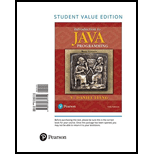
Introduction to Java Programming and Data Structures: Brief Version (11th Global Edition)
11th Edition
ISBN: 9780134671710
Author: Y. Daniel Liang
Publisher: PEARSON
expand_more
expand_more
format_list_bulleted
Question
Chapter 21.2, Problem 21.2.4CP
Program Plan Intro
Set:
Set is a data structure that is used for storing and processing non duplicate elements. It is an interface which extends collection and it is an unordered collection of objects.
Set is implemented by LinkedSet, HashSet or a TreeSet.
Expert Solution & Answer
Want to see the full answer?
Check out a sample textbook solution
Students have asked these similar questions
show all the work
answer question 3
Show the work
Chapter 21 Solutions
Introduction to Java Programming and Data Structures: Brief Version (11th Global Edition)
Ch. 21.2 - Prob. 21.2.1CPCh. 21.2 - Prob. 21.2.2CPCh. 21.2 - Prob. 21.2.3CPCh. 21.2 - Prob. 21.2.4CPCh. 21.2 - Prob. 21.2.5CPCh. 21.2 - Suppose set1 is a set that contains the strings...Ch. 21.2 - Prob. 21.2.7CPCh. 21.2 - Prob. 21.2.8CPCh. 21.2 - What will the output be if lines 67 in Listing...Ch. 21.2 - Prob. 21.2.10CP
Ch. 21.3 - Prob. 21.3.1CPCh. 21.3 - Suppose you need to write a program that stores...Ch. 21.3 - Suppose you need to write a program that stores...Ch. 21.3 - Suppose you need to write a program that stores a...Ch. 21.3 - Prob. 21.3.5CPCh. 21.3 - Prob. 21.3.6CPCh. 21.4 - Prob. 21.4.1CPCh. 21.4 - Prob. 21.4.2CPCh. 21.5 - Prob. 21.5.1CPCh. 21.5 - Prob. 21.5.2CPCh. 21.5 - Prob. 21.5.3CPCh. 21.6 - Prob. 21.6.1CPCh. 21.6 - Prob. 21.6.2CPCh. 21.6 - Prob. 21.6.3CPCh. 21.6 - Prob. 21.6.4CPCh. 21.7 - Prob. 21.7.1CPCh. 21.7 - Prob. 21.7.2CPCh. 21 - Prob. 21.1PECh. 21 - (Display nonduplicate words in ascending order)...Ch. 21 - Prob. 21.3PECh. 21 - (Count consonants and vowels) Write a program that...Ch. 21 - Prob. 21.6PECh. 21 - (Revise Listing 21.9, CountOccurrenceOfWords.java)...Ch. 21 - Prob. 21.8PECh. 21 - Prob. 21.9PE
Knowledge Booster
Similar questions
- Capsim Team PowerPoint Presentations - Slide Title: Key LearningsWhat were the key learnings that you discovered as a team through your Capsim simulation?arrow_forwardWrite the SQL code that permits to implement the tables: Student and Transcript. NB: Add the constraints on the attributes – keys and other.arrow_forwardDraw an ERD that will involve the entity types: Professor, Student, Department and Course. Be sure to add relationship types, key attributes, attributes and multiplicity on the ERD.arrow_forward
- Draw an ERD that represents a book in a library system. Be sure to add relationship types, key attributes, attributes and multiplicity on the ERD.arrow_forward2:21 m Ο 21% AlmaNet WE ARE HIRING Experienced Freshers Salesforce Platform Developer APPLY NOW SEND YOUR CV: Email: hr.almanet@gmail.com Contact: +91 6264643660 Visit: www.almanet.in Locations: India, USA, UK, Vietnam (Remote & Hybrid Options Available)arrow_forwardProvide a detailed explanation of the architecture on the diagramarrow_forward
- hello please explain the architecture in the diagram below. thanks youarrow_forwardComplete the JavaScript function addPixels () to calculate the sum of pixelAmount and the given element's cssProperty value, and return the new "px" value. Ex: If helloElem's width is 150px, then calling addPixels (hello Elem, "width", 50) should return 150px + 50px = "200px". SHOW EXPECTED HTML JavaScript 1 function addPixels (element, cssProperty, pixelAmount) { 2 3 /* Your solution goes here *1 4 } 5 6 const helloElem = document.querySelector("# helloMessage"); 7 const newVal = addPixels (helloElem, "width", 50); 8 helloElem.style.setProperty("width", newVal); [arrow_forwardSolve in MATLABarrow_forward
arrow_back_ios
SEE MORE QUESTIONS
arrow_forward_ios
Recommended textbooks for you
 EBK JAVA PROGRAMMINGComputer ScienceISBN:9781337671385Author:FARRELLPublisher:CENGAGE LEARNING - CONSIGNMENT
EBK JAVA PROGRAMMINGComputer ScienceISBN:9781337671385Author:FARRELLPublisher:CENGAGE LEARNING - CONSIGNMENT Programming with Microsoft Visual Basic 2017Computer ScienceISBN:9781337102124Author:Diane ZakPublisher:Cengage Learning
Programming with Microsoft Visual Basic 2017Computer ScienceISBN:9781337102124Author:Diane ZakPublisher:Cengage Learning New Perspectives on HTML5, CSS3, and JavaScriptComputer ScienceISBN:9781305503922Author:Patrick M. CareyPublisher:Cengage Learning
New Perspectives on HTML5, CSS3, and JavaScriptComputer ScienceISBN:9781305503922Author:Patrick M. CareyPublisher:Cengage Learning Microsoft Visual C#Computer ScienceISBN:9781337102100Author:Joyce, Farrell.Publisher:Cengage Learning,
Microsoft Visual C#Computer ScienceISBN:9781337102100Author:Joyce, Farrell.Publisher:Cengage Learning, C++ Programming: From Problem Analysis to Program...Computer ScienceISBN:9781337102087Author:D. S. MalikPublisher:Cengage Learning
C++ Programming: From Problem Analysis to Program...Computer ScienceISBN:9781337102087Author:D. S. MalikPublisher:Cengage Learning

EBK JAVA PROGRAMMING
Computer Science
ISBN:9781337671385
Author:FARRELL
Publisher:CENGAGE LEARNING - CONSIGNMENT


Programming with Microsoft Visual Basic 2017
Computer Science
ISBN:9781337102124
Author:Diane Zak
Publisher:Cengage Learning

New Perspectives on HTML5, CSS3, and JavaScript
Computer Science
ISBN:9781305503922
Author:Patrick M. Carey
Publisher:Cengage Learning

Microsoft Visual C#
Computer Science
ISBN:9781337102100
Author:Joyce, Farrell.
Publisher:Cengage Learning,

C++ Programming: From Problem Analysis to Program...
Computer Science
ISBN:9781337102087
Author:D. S. Malik
Publisher:Cengage Learning